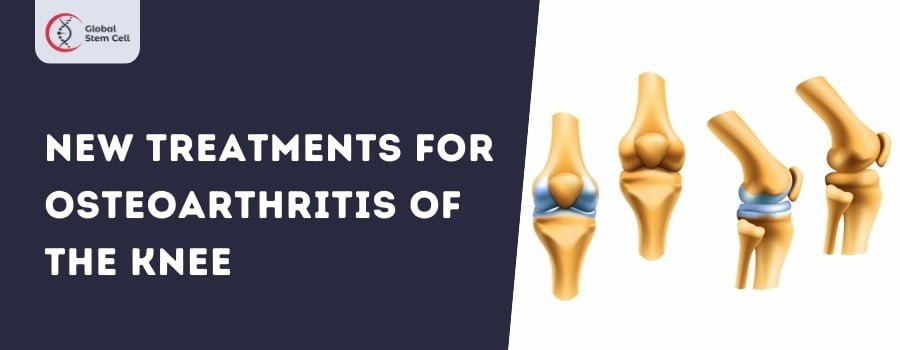
Navigating New Paths – Advancements in Treating Knee Osteoarthritis
Table of Content
Knee osteoarthritis (OA) is a degenerative joint disease that affects millions worldwide, causing pain, stiffness, and decreased mobility. For years, treatment options have focused on managing symptoms and slowing the progression of the disease. However, recent advancements offer a glimmer of hope: stem cell therapy.
This blog post delves into the exciting possibilities of stem cell therapy for knee OA, exploring its potential to not just manage symptoms but potentially regenerate damaged cartilage and improve joint function. We’ll discuss the science behind stem cell therapy, its current stage of development, and the potential benefits it holds for individuals struggling with knee OA.
Understanding Osteoarthritis of the Knee
Osteoarthritis (OA) of the knee is a degenerative joint disease that primarily affects the cartilage, the protective tissue that covers the ends of bones in a joint. It is the most common form of arthritis and often occurs in weight-bearing joints like the knees.
Here are some key points to help you understand osteoarthritis of the knee:
Cartilage Degeneration: In a healthy knee joint, cartilage provides a smooth surface for the bones to glide over during movement. In osteoarthritis, the cartilage gradually breaks down and wears away, leading to friction between the bones.
Risk Factors: Several factors can contribute to the development of knee osteoarthritis, including age, genetics, obesity, joint injuries, and overuse. Aging is a significant risk factor, as the wear and tear on joints increase over time.
Symptoms: Common symptoms of knee osteoarthritis include pain, stiffness, swelling, and a decreased range of motion. Pain is often worse after periods of inactivity or excessive use of the joint. In advanced stages, individuals may experience pain even at rest.
Diagnosis: Healthcare professionals typically diagnose knee osteoarthritis through a combination of medical history, physical examination, and imaging studies such as X-rays or magnetic resonance imaging (MRI). These tests help assess the extent of cartilage damage and rule out other potential causes of knee pain.
Disease Progression: Osteoarthritis is a progressive condition, and its severity can vary from person to person. Early intervention and effective management can help slow down the progression and improve the quality of life for individuals with knee osteoarthritis.
Conventional Treatment Approaches
Conventional treatment approaches for osteoarthritis of the knee typically focus on managing symptoms, reducing pain, and improving joint function. These approaches can be tailored to the individual’s needs and the severity of their condition. Here are some common conventional treatments:
Lifestyle Modifications
Weight Management: Maintaining a healthy weight is crucial as excess weight places additional stress on the knee joints. Weight loss can help reduce symptoms and slow down the progression of osteoarthritis.
Exercise: Low-impact exercises, such as walking, swimming, and cycling, can help improve joint flexibility, strengthen muscles around the knee, and enhance overall joint function. Physical therapy programs may be prescribed to address specific needs.
Medications
Pain Relievers: Over-the-counter pain medications like acetaminophen or nonsteroidal anti-inflammatory drugs (NSAIDs) such as ibuprofen can help manage pain and reduce inflammation.
Topical Analgesics: Creams, gels, or patches containing NSAIDs or capsaicin can be applied directly to the skin over the affected joint for localized pain relief.
Prescription Medications: In some cases, stronger pain medications or disease-modifying osteoarthritis drugs (DMOADs) may be prescribed.
Physical Therapy
A physical therapist can design a customized exercise program to strengthen muscles, improve joint flexibility, and enhance overall mobility. They may also provide techniques for managing pain and improving joint function.
Assistive Devices
Braces and Supports: These devices can provide stability to the knee joint and help alleviate pain during movement.
Orthotic Inserts: Shoe inserts can help distribute weight more evenly and reduce pressure on the knee joints.
Injections
Corticosteroid Injections: These injections deliver anti-inflammatory medication directly into the knee joint, providing temporary relief from pain and inflammation.
Hyaluronic Acid Injections: Also known as viscosupplementation, these injections aim to lubricate the joint and improve shock absorption, potentially reducing pain.
Surgical Interventions
Arthroscopy: A minimally invasive procedure involving the insertion of a small camera and surgical instruments into the joint to remove loose cartilage or smooth surfaces.
Osteotomy: Involves reshaping the bones around the knee to redistribute weight and relieve pressure on the damaged joint.
Joint Replacement (Arthroplasty): In severe cases, when other interventions are not effective, partial or total knee replacement surgery may be recommended.
The potential of Stem Cell Therapy for Osteoarthritis of the Knee Treatment
Stem cell therapy is an area of regenerative medicine that holds promise for treating osteoarthritis of the knee. While research in this field is ongoing, early studies and clinical trials suggest that stem cell therapy may have the potential to slow down the progression of osteoarthritis, reduce pain, and improve joint function. Here’s an overview of the potential of stem cell therapy for osteoarthritis of the knee:
Stem Cells Types
- Mesenchymal Stem Cells (MSCs): These are multipotent cells that have the ability to differentiate into various cell types, including cartilage, bone, and fat cells. MSCs can be derived from various sources, such as bone marrow, adipose tissue (fat), or umbilical cord tissue.
Mechanism of Action
- Cartilage Repair: Stem cells may contribute to cartilage repair by differentiating into chondrocytes, which are the cells that make up cartilage.
- Anti-Inflammatory Effects: Stem cells have anti-inflammatory properties, which can help reduce inflammation in the joint, a common feature of osteoarthritis.
- Release of Growth Factors: Stem cells release growth factors that stimulate tissue repair and regeneration.
Clinical Trials and Studies
- Some clinical trials and studies have shown promising results in terms of pain reduction, improved joint function, and increased cartilage volume in patients with knee osteoarthritis who underwent stem cell therapy.
- However, it’s important to note that the field is still in the early stages, and more research is needed to establish the safety, efficacy, and long-term effects of stem cell therapy for osteoarthritis.
Sources of Stem Cells
- Autologous (Patient’s Own) Stem Cells: In many cases, stem cells used for osteoarthritis treatment are derived from the patient’s own bone marrow or adipose tissue. This minimizes the risk of rejection or adverse reactions.
- Allogeneic (Donor) Stem Cells: Some studies explore the use of stem cells from donors, but this raises challenges related to immune compatibility.
Administration Methods
- Intra-Articular Injections: Stem cells can be directly injected into the knee joint, guided by imaging techniques such as fluoroscopy or ultrasound.
- Surgical Implantation: In some cases, stem cells may be combined with scaffolds or matrices and surgically implanted to enhance tissue repair.
Challenges and Considerations:
- Regulatory Approval: Stem cell therapy for osteoarthritis is not yet universally approved or regulated. It’s essential to participate in clinical trials conducted under ethical and regulatory guidelines.
- Variable Results: The effectiveness of stem cell therapy can vary among individuals, and not all patients may experience the same level of improvement.
- Cost and Accessibility: Stem cell therapy can be expensive, and accessibility may be limited in some regions.
Patient Success Story
Best Countries for Stem Cell Treatment for osteoarthritis of the Knee
The availability and regulation of stem cell treatment for osteoarthritis of the knee can vary significantly from one country to another. Factors to consider when evaluating the suitability of a country for stem cell treatment include the regulatory environment, the expertise of medical professionals, the quality of healthcare facilities, and the cost of treatment. Here’s an overview of the potential considerations for each of the countries you mentioned:
Mexico
- Mexico has become a popular destination for medical tourism, including stem cell therapy.
- Stem cell treatments may be available at hospitals, but it’s essential to thoroughly research the credentials and reputation of the facility and healthcare providers.
- Mexico may offer more affordable options compared to some other countries, but quality and safety standards can vary.
Thailand
- Thailand is known for its advanced healthcare infrastructure and expertise in medical tourism.
- Stem cell therapy for osteoarthritis may be available at reputable hospitals and specialized clinics.
- Thailand’s healthcare system adheres to international standards, and the country has regulations in place to ensure patient safety and quality of care.
India
- India is home to many world-class medical facilities and highly skilled healthcare professionals.
- Stem cell therapy for osteoarthritis may be available at specialized clinics in major cities like Delhi, Mumbai, or Bangalore.
- India offers a wide range of treatment options at relatively lower costs compared to Western countries, making it an attractive destination for medical tourists.
Ready to take the next step towards a healthier, pain-free life? Explore stem cell therapy options for osteoarthritis treatment today. Contact us to schedule a consultation and discover personalized solutions for your journey to joint wellness. Your path to relief starts here!





